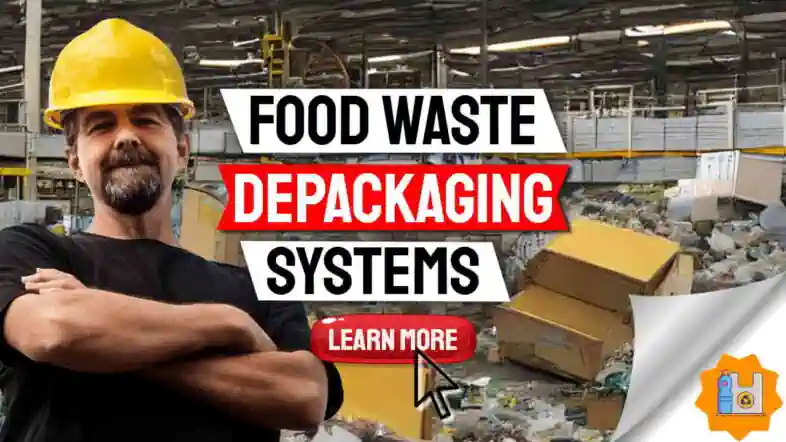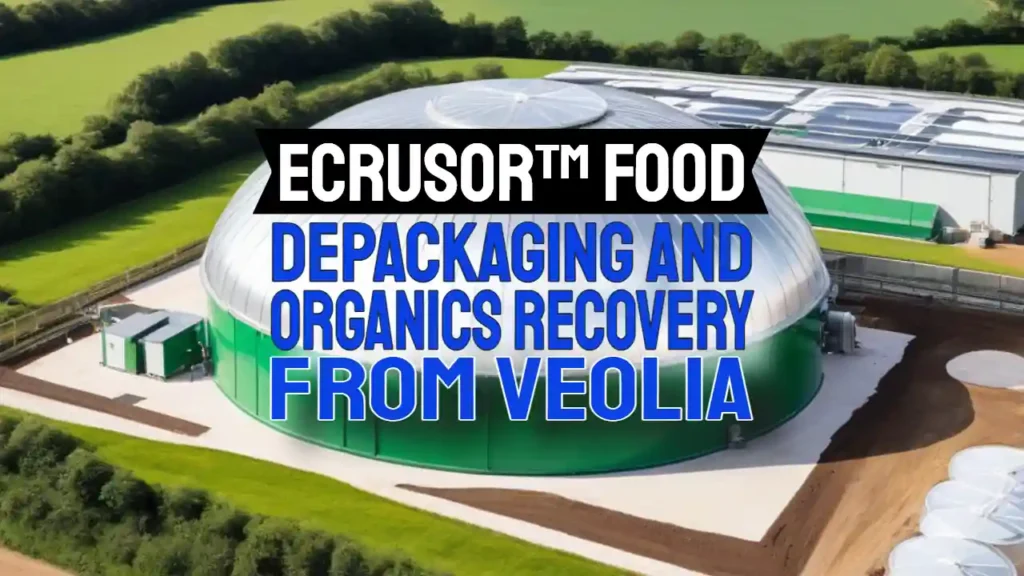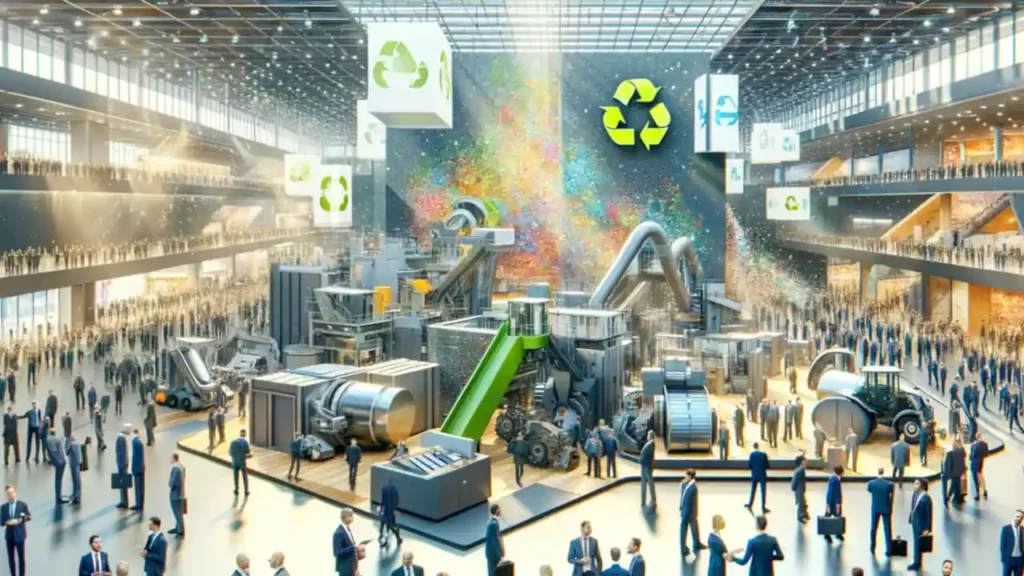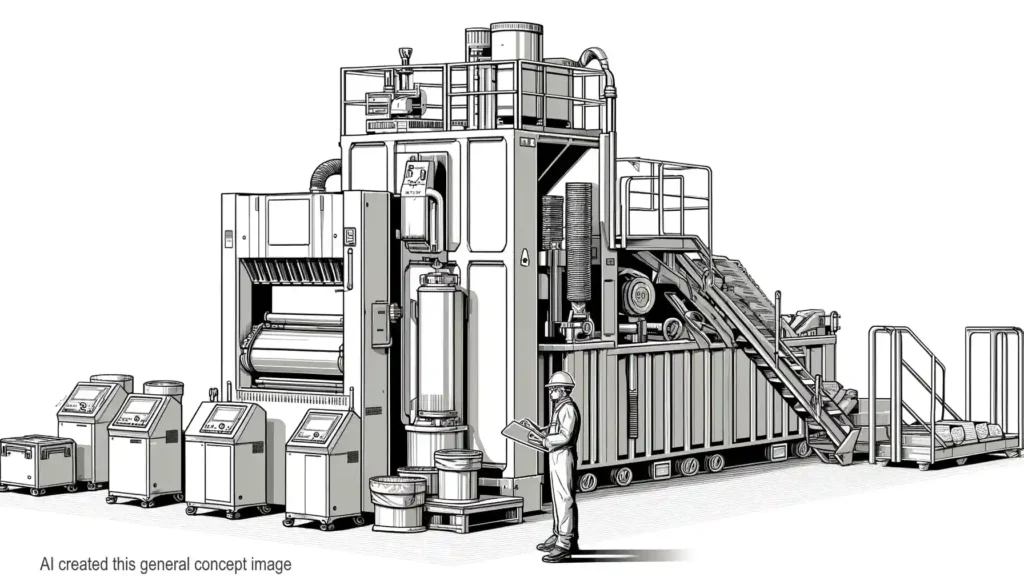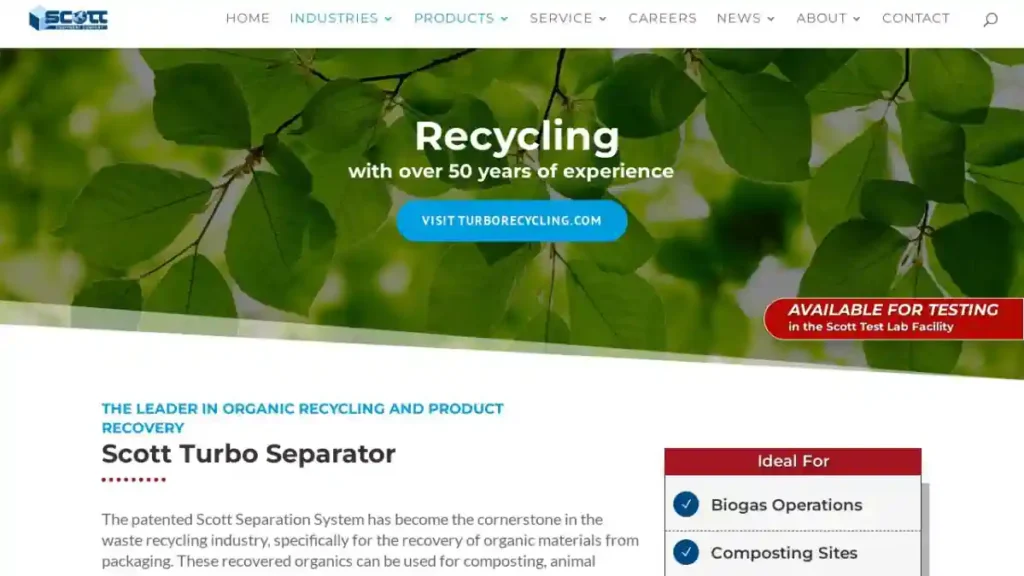Struggling to cut costs and boost efficiency in your packaging processes? Many businesses find depackaging expensive and hard to manage. This affects your supply chain, leads to more waste, and lowers your return on investment (ROI).
One key fact: Automation in depackaging can cut costs by reducing labour needs and speeding up the process. It’s a game-changer for those looking to improve their packaging lines without breaking the bank.
In this article, we’ll cover strategies like optimising material storage and using advanced technology. We’ll also discuss economic benefits such as reduced waste, lower operational costs, and better ROI from recyclable materials.
Keep reading… The solutions are simple yet effective!
Key Takeaways
- Automation reduces packing time and labour costs. Tools like Water Activated Paper Tape Dispensers can save up to 13% in packing costs. Automated Pallet Wrappers might cut wrapping expenses by 50%.
- Advanced sorting technology, such as AI-powered systems and NIR, increases waste management efficiency. These innovations help recover more valuable materials and reduce landfill waste.
- Efficient depackaging processes lower operational costs. Systems like the Drycake Twister Depackaging System offer over 99.5% clean organic material separation and can save up to $1,000,000 annually.
- Using smaller packaging options reduces shipping costs. Just-In-Time (JIT) models also lower inventory expenses, promoting eco-friendly practices.
- Effective maintenance extends equipment life and efficiency. Regular inspections, proper lubrication, and timely software updates are key practices for managing depackaging machinery effectively.
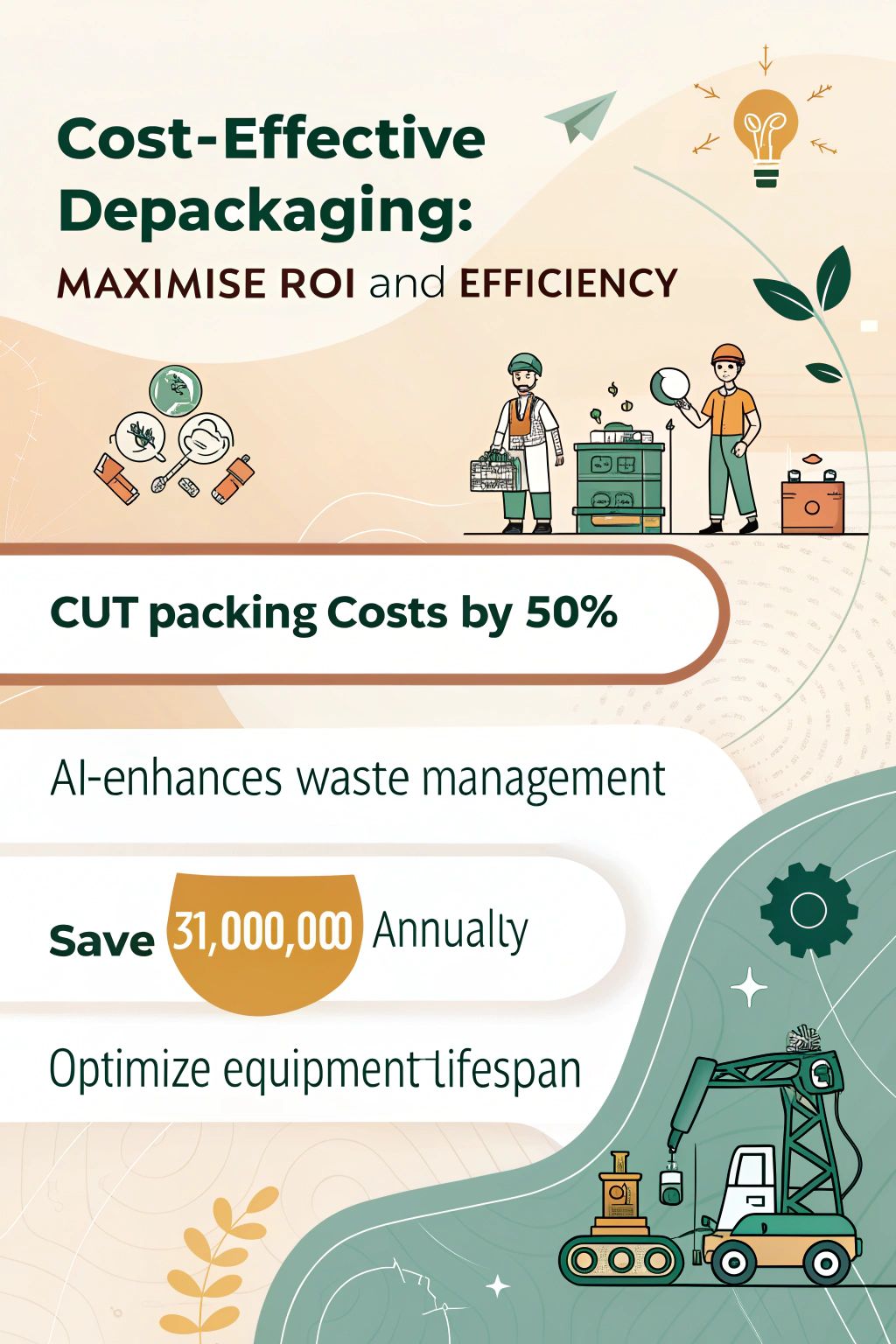
Key Strategies for Cost-Effective Depackaging
Effective depackaging boosts efficiency and cuts costs. Focus on improving material storage and adopting better packaging methods for a higher return on investment.
Optimising Material Storage and Packaging Lines
Improving material storage reduces waste. It cuts shipping expenses too. Use lean principles to enhance efficiency and eliminate waste in the process.
Regularly assess your packing lines. Streamline processes to save costs and increase productivity. Data analysis can pinpoint bottlenecks—fix those for smoother operations.
Efficient storage enhances overall operational efficiency.
Integrating Automation to Reduce Packing Time
Automation cuts packing time and costs. Advanced machines fill, seal, label, and palletise materials quickly. Water Activated Paper Tape Dispensers can save up to 13% in packing costs.
Automated Pallet Wrappers might reduce wrapping expenses by 50%. These tools speed up processes while lowering labour needs.
In waste management, efficiency is key. Using automated systems means faster handling of recycled materials and reduced waste disposal times. This leads to better resource recovery and lower operational costs for companies dealing with recyclables or sustainable packaging options.
Employing Smaller, More Efficient Packaging Options
Integrating automation reduces packing time but it is also crucial to use smaller, more efficient packaging. Dimensional pricing encourages companies to choose compact boxes. This cuts down shipping costs and storage expenses.
Implementing a Just-In-Time (JIT) model for packaging helps lower inventory costs even further. Smaller packages reduce waste and enhance customer perception with better design. Strategic packaging can keep products safe yet be eco-friendly, boosting sustainability efforts and supporting a circular economy.
Technological Innovations Enhancing Depackaging Efficiency
New technology makes depackaging faster and smarter. These tools can sort waste better and use data to improve the process… making everything work smoother.
Advanced Sorting Technology
AI-powered optical sorting systems can transform waste management. These systems use cameras and sensors to identify different materials, increasing efficiency. Near-Infrared (NIR) technology detects plastics by their polymer type.
This accuracy helps recyclers recover more valuable materials.
Robotic arms also boost sorting capabilities. They can sort faster than human workers, making processes quicker and more cost-effective. Yet, advanced robots require regular maintenance, which adds to costs.
But the improved efficiency often offsets these expenses.
Technology is transforming how we manage waste, says a leading recycling expert.
Using these innovations reduces landfill waste and promotes sustainable products in the market…. enhancing overall environmental quality.
Smart, Data-Driven Plant Optimisation
Advanced sorting technology is just the beginning. Smart, data-driven plant optimisation pushes efficiency even further. STADLERconnect uses cloud services to streamline sorting plant performance.
Sensors and machine data monitoring offer real-time tracking of equipment. Predictive maintenance flags issues before they become big problems, cutting down downtime. New modules like Windshifter Automation and Infeed Decision Aid are on their way.
Waste management professionals can use this tech to reduce energy consumption and operational costs while maximising recyclable waste recovery. This approach leads to better ROI and a greener future for everyone involved.
The Drycake Twister Depackaging System
Efficient plant optimisation can boost performance. Next, explore the Drycake Twister Depackaging System… This system boasts over 99.5% clean organic material separation, far surpassing traditional depackagers with an 80% recovery rate.
The Drycake Twister delivers significant savings. It can save between $600,000 and $1,000,000 annually. Remarkably, it pays for itself in as little as ten months—making it a cost-effective option for waste management professionals aiming to reduce packaging waste and operational costs while maximising ROI from recyclable materials.
Economic Benefits of Improved Depackaging Processes
Effective depackaging means less waste and reduced costs… making it a win-win for businesses. Continue reading to discover more benefits!
Reduction in Material Waste
Reducing material waste saves money and is good for the environment. Using systems like Tecnofer, companies can achieve zero disposal costs. Waste from unsold or expired food products can be repurposed instead of dumped in landfills.
The beauty industry also benefits by reusing separated materials, lowering disposal costs further. This helps in waste reduction and enhances a company’s sustainability goals and corporate reputation.
Lower Operational Costs
Investing in depackaging technology can seem costly at first, but it pays off. These systems cut down on landfill fees and increase revenue from recycled materials. Tax incentives and subsidies help too.
Governments support sustainable waste management practices, making the initial cost easier to bear.
Automated depackaging reduces labour expenses. Machines work faster than people and need less human oversight. This means fewer workers are needed for the same tasks, lowering payroll costs significantly.
Initial investments in depackaging technology typically offset future costs.
Less material waste also lowers operational costs. Efficient machines ensure that little goes to landfill, saving money on disposal fees while boosting returns from recyclable goods like high-density polyethylene (HDPE).
Enhanced ROI from Recyclable Materials
Efficient depackaging increases the value of recyclable materials. Tecnofer’s systems are a great example, as they cut disposal costs and boost profits. These systems help reduce waste by extracting valuable items from garbage.
Using smart sorting technology can also enhance ROI. It separates different materials quickly, improving recyclability and saving time. This streamlines operations and ensures more materials can be sold or reused, maximising returns for companies in waste management.
Overcoming Challenges in Depackaging
Switching to new tech can be tricky. Factor in the cost of initial investments….
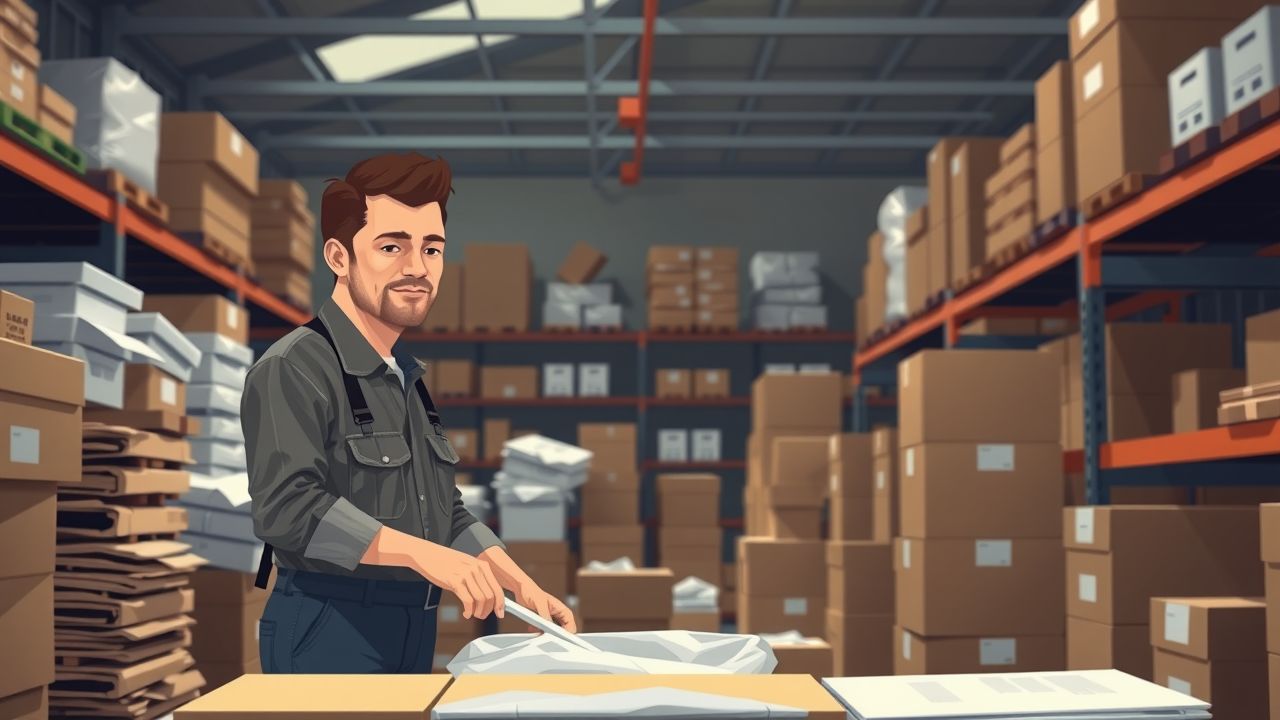
Adjusting to New Technologies
Adapting to new technology in depackaging can seem tricky. Yet, it’s crucial for staying efficient and cost-effective. Automation plays a big role here. It speeds up tasks and reduces the need for manual labour.
This lowers operational costs.
Data-driven plant optimisation is another game-changer. Smart systems analyse performance and suggest improvements. These innovations help reduce waste and save money in the long run.
Consider integrating these tools to enhance your processes: advanced sorting technology or the Drycake Twister Depackaging System might be useful options.
Now that we’ve discussed adapting to new tech…
Managing Initial Investment Costs
New technologies bring change. It can be expensive to start using depackaging equipment. But the benefits often make it worth it.
Initial investments are high. Yet, they can reduce landfill fees and increase efficiency. Small businesses may find these costs steep at first glance. Governments often help with tax incentives or subsidies for sustainable waste management practices.
Suppliers offer state-of-the-art technology that promises reliability and reduced long-term expenditures. Many equipment providers also include maintenance in their packages, which helps manage holding costs more effectively.
Waste management professionals should consider energy-efficient appliances as part of their investment strategy. These help save on operational expenses in the long run, thus enhancing overall ROI from recycling efforts.
Maintenance Best Practices and Tips for Depackaging Equipment
Proper maintenance of depackaging equipment ensures efficiency. It also extends the lifespan of the machinery.
- Establish a Maintenance Schedule
Create a routine schedule. Follow it strictly to avoid unnecessary downtime. - Conduct Routine Inspections
Regular inspections catch issues early. Check for wear and tear on moving parts. - Lubrication and Cleaning
Lubricate all moving parts regularly to prevent friction. Clean machines to avoid buildup and rust. - Calibration Checks
Ensure the equipment operates at peak performance by calibrating sensors and scales often. - Use Quality Parts for Repairs
Use high-quality replacement parts. Low-grade components can lead to frequent breakdowns. - Train Staff Properly
Train your team on proper use and minor troubleshooting. Well-trained staff can prevent many errors. - Keep a Spare Parts Inventory
Maintain an inventory of spare parts to reduce downtime during repairs. - Implement Software Updates Promptly
Update software systems regularly. This keeps your technology current and efficient. - Monitor Energy Consumption
Keep an eye on energy use, aiming for higher energy efficiency in operations.
Conclusion
Cost-effective depackaging can transform your operations. With better machines, automated lines, and smart tech, you boost efficiency. The result? Lower costs and higher returns. Make the switch today for a greener future!
For more detailed guidance on keeping your equipment in top condition, please visit our maintenance best practices and tips for depackaging equipment.
FAQs
1. What is cost-effective depackaging?
Cost-effective depackaging involves removing packaging materials from products in a way that maximises ROI and efficiency, often turning waste products into renewable energy sources like refuse derived fuel or mulch.
2. How does depackaging contribute to energy savings?
Depackaging helps convert food waste and other scraps into renewable energy, such as wind energy or hydroelectric systems, thus reducing reliance on traditional grid electricity and saving costs.
3. Can depackaging help with corporate social responsibility (CSR)?
Yes, companies can use smart packaging designs and active packaging strategies to minimise waste product generation, contributing positively to their CSR goals by promoting sustainable technology.
4. What role does data analytics play in the depackaging process?
Data analytics allows businesses to track key performance indicators (KPIs) related to consumer behavior, risk analysis, and supply chain management—helping optimise the entire process for better efficiency.
5. Is it better to handle depackaging in-house or outsource it?
Deciding between in-house or outsourced solutions depends on factors like onboarding costs, employee retention rates, training needs, and overall impact on just-in-time inventory systems.
6. How does digital marketing relate to cost-effective depackaging?
Digital marketing informs consumers about eco-friendly practices through advertising campaigns focused on topics like e-waste reduction and sustainable packaging materials—building brand loyalty while educating the mass market about environmental benefits.
References
- https://itbpackaging.com/packaging-optimization/efficient-packaging-operations/ (2024-03-27)
- https://www.logiwa.com/blog/reduce-packaging-costs
- https://networkpack.co.uk/4-quick-cost-effective-packaging-automation-options/ (2021-05-26)
- https://enoline.com/en/articles/cost-effective-packaging-strategies/ (2024-08-22)
- https://www.gwp.co.uk/guides/cost-effective-packaging-design/ (2024-02-16)
- https://recyclinginside.com/recycling-technology/separation-and-sorting-technology/innovations-in-advanced-sorting-technologies-for-recyclable-materials/ (2024-01-26)
- https://www.ieabioenergy.com/blog/publications/advanced-sorting-technologies-in-the-waste-sector-case-studies-compilation/
- https://stadler-engineering.com/company/news/detail/stadler-digital-solutions-transforming-recycling-with-smart-data-driven-plant-optimisation
- https://www.recycling-magazine.com/2024/11/13/transforming-recycling-with-smart-data-driven-plant-optimisation/
- https://www.twisterseparator.com/
- https://recyclinginside.com/recycling-technology/separation-and-sorting-technology/slash-your-costs-and-boost-income-with-the-drycake-twister-depackaging-system/
- https://www.tecnofer.biz/en/depackaging/
- https://thinkviably.com/resource-library/costs-of-not-depackaging-food-waste/
- https://www.slrecyclingltd.co.uk/what-are-the-economic-benefits-of-recycling/ (2023-08-29)
- https://www.researchgate.net/publication/305923016_Adapting_to_Fast-Changing_Markets_and_Technologies (2024-10-22)
- https://aicontentfy.com/en/blog/strategies-for-reducing-costs-and-maximizing-roi (2024-08-12)
- http://www.organics-recycling.org.uk/uploads/article1762/Depacking%20Equipment.pdf
- https://www.pdachain.com/2024/06/10/packaging-equipment-maintenance-best-practices-for-longevity-and-efficiency/ (2024-06-10)
Discover more from IPPTS Depackaging Equipment Insights
Subscribe to get the latest posts sent to your email.


